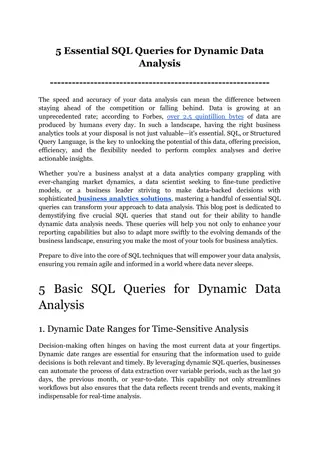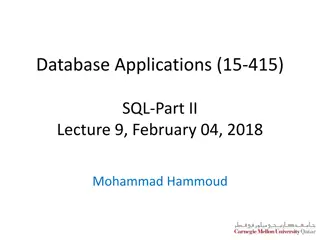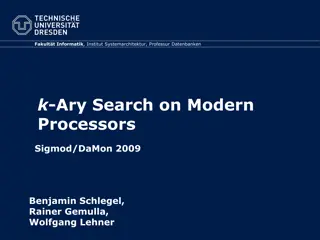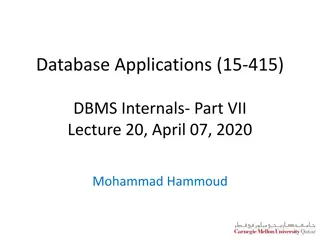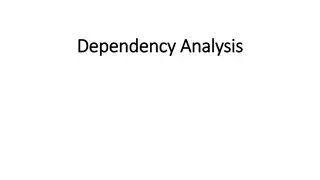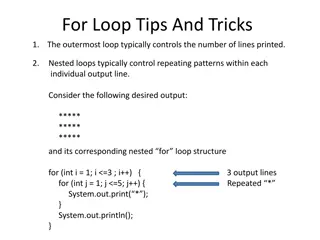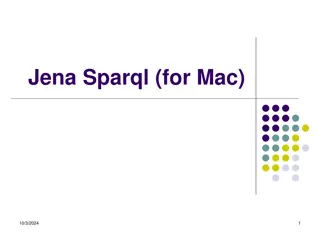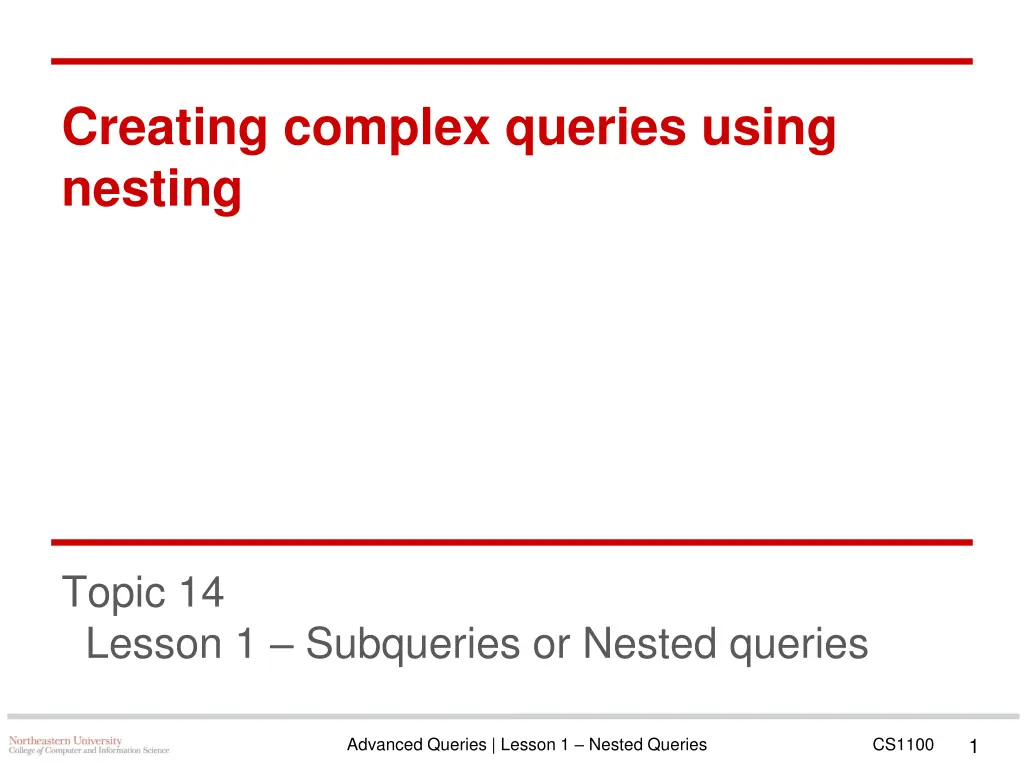
Advanced Queries Using Nested Subqueries in Database Design
Learn how to create complex queries using nested subqueries in database design. Subqueries allow you to use the results of one query as a field or criterion in another query. Explore examples of subqueries for filtering and counting data effectively.
Download Presentation

Please find below an Image/Link to download the presentation.
The content on the website is provided AS IS for your information and personal use only. It may not be sold, licensed, or shared on other websites without obtaining consent from the author. If you encounter any issues during the download, it is possible that the publisher has removed the file from their server.
You are allowed to download the files provided on this website for personal or commercial use, subject to the condition that they are used lawfully. All files are the property of their respective owners.
The content on the website is provided AS IS for your information and personal use only. It may not be sold, licensed, or shared on other websites without obtaining consent from the author.
E N D
Presentation Transcript
Creating complex queries using nesting Topic 14 Lesson 1 Subqueries or Nested queries Advanced Queries | Lesson 1 Nested Queries CS1100 1
Nested Queries Some complex queries must be based on the results of other queries. The result of a query is a virtual table, i.e., something that looks and can be used like a table, but is not actually stored in the database as a table. A query can be used (as a table is used) in the design of a query. Advanced Queries | Lesson 1 Nested Queries CS1100 2
Subqueries A subquery is a query statement that s nested inside of another query. Sometimes need to use the results of a query as a field in another query, or as a criterion for a query field. Example: How many orders have a total under $2,000? To find the answer, first need to calculate order totals and filter out those that are $2,000 and under. Then do a count. Advanced Queries | Lesson 1 Nested Queries CS1100 3
The Database Layout These are all of the tables in the database: Advanced Queries | Lesson 1 Nested Queries CS1100 4
Example Query I How many orders were placed that had a total of less than $2000? Advanced Queries | Lesson 1 Nested Queries CS1100 5
Step 1: Total for Each Order? Design View Datasheet View Using the Principle of Simplest Query we break this query into two subqueries: Widening, then Aggregation. Advanced Queries | Lesson 1 Nested Queries CS1100 6
Step 2: Filter Orders Less Than $2,000? Design View Datasheet View The Principle of Simplest Query would break this query into three subqueries (widening, followed by aggregation, followed by selection). A more descriptive alias for OrderTotals is FilteredOrderTotals. Advanced Queries | Lesson 1 Nested Queries CS1100 7
Step 3: Count the Resulting Rows Build a new query with the previous query as a subquery Datasheet View Design View Advanced Queries | Lesson 1 Nested Queries CS1100 8
Example Query II Who placed these orders less than $2,000? Use OrdersTotal again as a subquery Combine with Orders and Contacts to get customer information Use Group By to remove duplicates There are 15 contacts in total Advanced Queries | Lesson 1 Nested Queries CS1100 9
Watch Out: Access Caches Queries Whenever Access executes a query it saves ( caches ) the result. When that query is used as a subquery, Access uses the cached result instead of running it again. If you then update the subquery, Access does not automatically refresh the result for the query that uses the subquery. Advanced Queries | Lesson 1 Nested Queries CS1100 10
Refreshing Queries To refresh all queries, you need to: Close all queries Click the right mouse button on the query tab and select Close Load the query again double-click on the query in the navigator This forces a refresh. Advanced Queries | Lesson 1 Nested Queries CS1100 11
Use Step by Step Decomposition How many orders are there that have a total value of less than $1000? Create a query that finds all orders with a value less than $1000 Save the query under an appropriate name Create another query based on the previous query that COUNTs all of the rows CAUTION: Do not modify or rename queries that are used as subqueries. Advanced Queries | Lesson 1 Nested Queries CS1100 12
Solution with Subqueries Subquery: OrdersLessThan1000 Note the use of the subquery and the aggregate COUNT function OrderLessThan1000 is a convenient shortcut, but violates WASE. We combine Widening, Aggregation and Selection in one query. So there are 21 orders with a total less than $1000 Advanced Queries | Lesson 1 Nested Queries CS1100 13
Example Query III What is the average cost of all orders? Note the use of the subquery and the aggregate AVG function Subquery: OrderTotals OrderTotals violates WASE. Exercise: rewrite using two queries: a Widening and an Aggregation subquery. Advanced Queries | Lesson 1 Nested Queries CS1100 14
Example Query IV How many different people bought each product? Attempted query Advanced Queries | Lesson 1 Nested Queries CS1100 15
Example: Counting Unique Occurrences How many different people bought each product? Attempted query Count of Contact IDs Advanced Queries | Lesson 1 Nested Queries CS1100 16
But Grouping by Contact IDs shows 2 different contacts ordered Product #8 Advanced Queries | Lesson 1 Nested Queries CS1100 17
Why? Let s remove the Totals and Ungroup. Advanced Queries | Lesson 1 Nested Queries CS1100 18
Why? Let s remove the Totals. Someone ordered it twice We have duplicates Group by removes duplicates but doesn t count. Count aggregates but doesn t remove duplicates. So what do we do? Advanced Queries | Lesson 1 Nested Queries CS1100 19
Solution Use subquery to perform grouping ProductContactNoDups Advanced Queries | Lesson 1 Nested Queries CS1100 20
Solution Use subquery to perform grouping, then count Advanced Queries | Lesson 1 Nested Queries CS1100 21
TRY FOR YOURSELF Access Queries Advanced Queries | Lesson 1 Nested Queries CS1100 22
Question 1 Which contacts placed three or more orders? Advanced Queries | Lesson 1 Nested Queries CS1100 23
Question 2 How many contacts placed three or more orders? Advanced Queries | Lesson 1 Nested Queries CS1100 24
Question 3 Which states had contacts that placed 3 or more orders? Advanced Queries | Lesson 1 Nested Queries CS1100 25
Maximum and Minimum What is the maximum amount of any order that was ever placed? What is the minimum amount of any order that was ever placed? Which order was the minimum order? Who placed the minimum (smallest) order? Advanced Queries | Lesson 1 Nested Queries CS1100 26
Maximum Query What is the maximum amount of any order that was ever placed? Advanced Queries | Lesson 1 Nested Queries CS1100 27
Maximum Query What is the maximum amount of any order that was ever placed? Use OrdersTotal again as a subquery Apply the MAX aggregate function Advanced Queries | Lesson 1 Nested Queries CS1100 28
Minimum Query What is the minimum amount of any order that was ever placed? Advanced Queries | Lesson 1 Nested Queries CS1100 29
Query What is the minimum amount of any order that was ever placed? Use OrdersTotal again as a subquery Apply the MIN aggregate function Advanced Queries | Lesson 1 Nested Queries CS1100 30
Minimum Order Query Which order was the minimum order? Advanced Queries | Lesson 1 Nested Queries CS1100 31
Minimum Order Query Which order was the minimum order? Requires the previous query and OrdersTotal as subqueries Can use one of two approaches Approach 1: Use Criteria Approach 2: Create Relationship Advanced Queries | Lesson 1 Nested Queries CS1100 32
Query Who placed the smallest order? Advanced Queries | Lesson 1 Nested Queries CS1100 33
Query Who placed the smallest order? Use previous query as subquery Combine with Orders and Contacts table Advanced Queries | Lesson 1 Nested Queries CS1100 34
Try this: Which orders contained a line item for the least expensive product (based on CurrentUnitPrice)? Who ordered the least expensive product? Advanced Queries | Lesson 1 Nested Queries CS1100 35
Parameterized Query To allow user input for a query value: specify a variable that has a name different from any of the field names Since the value for the field is unknown, the database queries the user for its value Advanced Queries | Lesson 1 Nested Queries CS1100 36
Hiding Subqueries Queries (and tables) can be hidden : Right-click on query in navigation panel Select Hide in this Group Advanced Queries | Lesson 1 Nested Queries CS1100 37
Unhiding Queries Click anywhere in the Query Explorer Select Navigation Options Check Show Hidden Objects Now all hidden queries are visible and can be unhidden. Advanced Queries | Lesson 1 Nested Queries CS1100 38
Summary Group By removes duplicate rows where the Group By values are the same Aggregate functions apply to groups or entire tables depending how they are used Subqueries are necessary to build complex queries Advanced Queries | Lesson 1 Nested Queries CS1100 39



